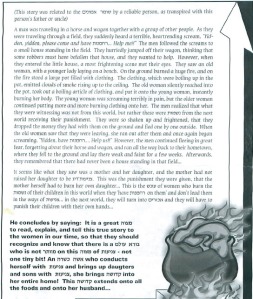Mordechai Shinefield has written about Jewish arts and culture for venues as varied as the Jewish Exponent, Spin Magazine, and the Village Voice. In 2005 he wrote about other strange Jewish urban legends for the Forward and wrote about Jewish themes in Grimm Fairy Tales as part of his MA in Performance Studies from NYU. This is his first post for Chakira.
In a time when American charedi controversies are blossoming, from stadium-filled Internet protests to molestation charges, there are apparently still transgressions lurid enough to shock. One such transgression, perpetrated by a Bnos Yaakov Elementary School, was reported by the community web blog The Lakewood View. If you were following the Internet protests at all you know how complicated a community position this blog must take just to exist. “A Concerned Parent” submitted to the blog a copy of a story that was handed out to all grades, setting off debates about the tale’s appropriateness for young audiences.
The handout tells the tale of some men attracted to a home by “heartrending” cries. There they find a woman boiling clothing and then draping the scalding clothing onto a younger woman. We find out quickly that the women are a mother and daughter. In ‘This World’ the mother allowed her daughter to dress immodestly. Now, in some Dante-esque contrapasso (or middah keneged middah) ‘Next World’ punishment, she is dressing her in burning garments.
The reactions, which range from defensiveness to apologetics to apoplectic rage, are predictable. Most people are rightfully horrified that young children are being scared into dressing more modestly. It is not like Bnos Yaakov students are particularly provocative dressers to begin with. Other people think it was mistakenly sent out, and should not disgrace an otherwise respectable school. A few people believe it’s a conspiracy theory to discredit Lakewood.
Few people have noticed how strange the story really is, and a remarkable intersection between Jewish narrative traditions and American ones. The Jewish flourishes are obvious. The story is told in English and Hebrew, the young woman yells for Rachmanus – mercy, it seems to take place in some anonymous shtetl, the punchline is an admonition to wear more modest clothing, etc.
The American tropes are the really interesting pieces. The story’s opening is textbook urban legend. “This story was related to the Shomer Emunim by a reliable person, as transpired with this person’s father or uncle.” Almost exactly like “I heard it from a friend of a friend,” or “the barber of a third cousin.” Just like the urban legend displaces the source of a story to lend the narrative authority, this story uses the same narrative trick to establish truthfulness in the eyes of the readers. Though the Shomer Emunim, aka the Revivalist Chassidic leader R’ Arele Roth (1894-1947), was a real person who famously claimed that immodesty caused the Holocaust, from there the story spirals into anonymity.
The burning daughter comes by way of southwest United States ghost traditions. We are told that “a man was traveling in a horse and wagon together with a group of other people.” We don’t know who he was, where he was going, or what his relationship to this group of other people are. True, they could be Chassidic men traveling to visit their Rebbe, but they are an amorphous enough group to be settlers crossing the plains. The burning itself is gothic Americana – Wicker Man style poetic torture. “They entered the little house,” it says. You know, the one on the prairie.
Finally, though not American specifically, one telling detail seems particularly fairy tale-esque in a way that calls to mind the Brothers Grimm. When the men flee the scene, “they were so shaken up and frightened, that they dropped the money they had with them on the ground and fled one by one outside.” What a strange detail to include! Why does it matter that they dropped their money on the way out? How did the money fall out of their pockets? Notably we are told that when they hear the young woman’s cries they “hurriedly jumped off their wagon, thinking that some robbers must have befallen that house.” It’s as though a second story has been redacted, some other rendition excised, or inserted poorly so that the lines still show.
Some of the blog’s commentators are troubled that the men don’t try to help the young woman. They suggest that if this story was non-fictional, the women were clearly involved in an abusive, predatory struggle. Our children, the thinking goes, should be taught to help screaming strangers, not to flee. Concerns of abuse loom large for many Orthodox parents. Those, of course, include the molestations in schools that take place over the course of decades. Not to mention the quotidian daily abuses, like discovering that your second grader has been given a story like this to read. Maybe that’s why this got passed around in the first place. All fairy tales and urban legends share one thing in common: They are terribly compelling to the people who tell them; they’re about images you just can’t get out of your mind.



I love the idea of considering Lakewood as an American Gothic setting. Hawthorne would have felt completely at home writing about dark-clad charedi communities hiding dark secrets, isolated and surrounded by strange wilderness, the suggestion of the supernatural, etc. Sort of like Naomi Ragen, but creepier and unresolved.
I take it then that you don’t think the story to be true 😉
I’m surprised that you didn’t discuss the central concept of punishment which seems to owe a lot to Dante.
Interestingly, in the original version (http://www.hebrewbooks.org/pdfpager.aspx?req=41981&st=&pgnum=105) it doesn’t mention they dropped their money out of fright. It says they left their horses and wagon. I guess horses and wagons aren’t so relatable now. The newsletter should have said they dropped their iphones.